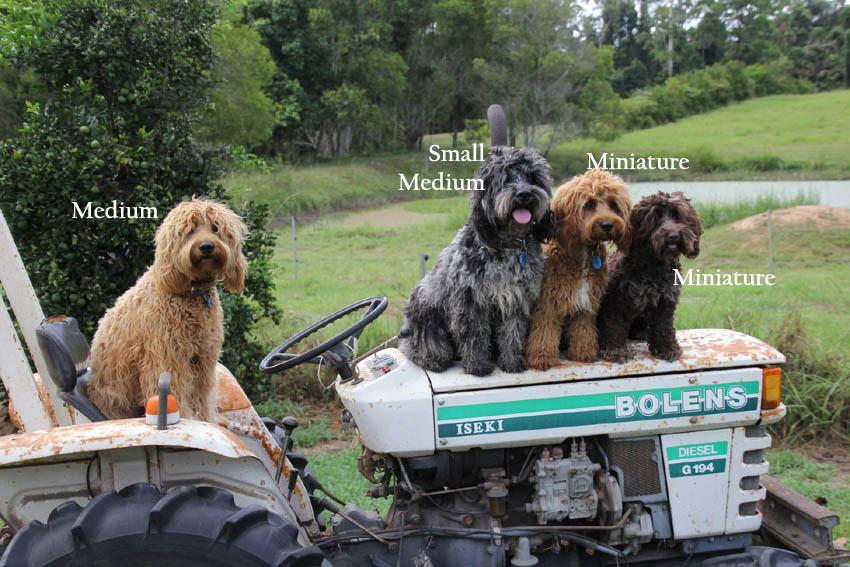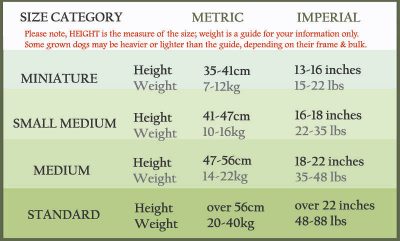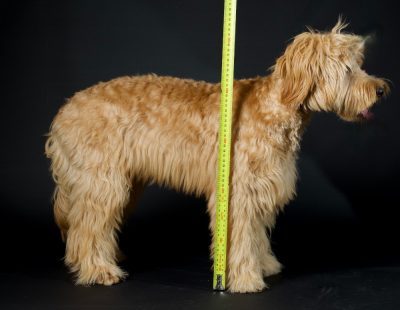
This is a question that families ask often, and we thought it was a good idea to write a blog to help you understand how big your puppy will grow, how quickly your puppy will grow, and how your puppy’s breed size category is predicted while it is still just a little pup!
Age and Development
At 6 months of age, your puppy will be 75% grown in height, and by 8 months they will usually be fully grown in height. Your puppy will then continue to fill out over a year or so. A healthy raw diet and appropriate activity and exercise will ensure your puppy grows to its potential in size and health.
Breed Size Guide
As breeders, we have breed guidelines to guide us in categorising our dog sizes. There are now 4 breed size categories for Cobberdogs, MINIATURE, SMALL MEDIUM, MEDIUM and STANDARD, although Ridgy Didge Cobberdogs does not breed standard dogs at this time. There is no TOY size in Cobberdogs.
The Australian Cobberdog breed sizes are determined by height not weight; measured from the floor to the top of the shoulder, called the wither - see the picture below. There is a range of size within each size category, and you can clearly see this in the difference between the two gorgeous miniature dogs in the feature picture above!
Weight is included in our table here, only as a guide to help you to understand what the fully grown dog may look like. There are variations in frame bulk and weight in dogs, just as there is with humans: you can have a 180cm slim person who weighs the same as a 160cm person of stocky build.
Breeding for Size
When we plan our upcoming litters there are lots of factors that are carefully considered; we’re going to talk about the factors that involve predicting puppy size, including breeding lines, genetics and breed continuity.
PARENTS: Size of parents is a good starting point. Just like human families, there is a tendency for offspring to be similarly sized to parents. Added to this, the grown size of the dog ancestors and previous litters gives us some good clues. However, just like human families, there will always be natural variations that are outside our control in the same way that children in a family will vary naturally.
PUPPY: Once born, the size of puppies at birth and their rate of development give us some predictors of the grown size. Occasionally, genetics surprises us and throws back a number of generations to a forbearer who was just that bit larger or smaller! See the image here of a litter of puppies that we were expecting to be small medium in size. As you can see, there is one little pup who is just as healthy and robust as the rest, but will almost certainly be a miniature. Same mother and same father, but we see a very different birth size! Another indicator of size can be size of paws though this is not definitive.

NOTE:
There is also a consideration in breeding, that to keep the Cobberdog characteristics, you do have to work on the edge of the bigger size to maintain the breed standard for that size; this ensures that the generations don’t get gradually smaller and change.
Your Requested Puppy Size
At allocation, we take into careful consideration the puppy size selection of our families, and also whether they have selected ‘bigger’ or ‘smaller’ in the event of their ideal size not being available at puppy time. The difference between a large miniature and a small medium dog is very little in height, and the exact fit is difficult to predict definitively by the time puppies are allocated. We really hope our families understand that we try our best to meet their wishes, and that there are some factors that are just beyond our control.
If you would like to adopt a Ridgy Didge Australian Cobberdog, please read our Adopting a Puppy information, before you continue the adoption process. For more information, pm us on Facebook, or contact us at our website. Like and follow us on Facebook to keep up to date with ongoing puppy news and announcements.


